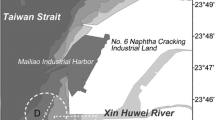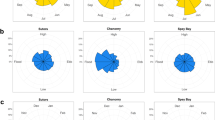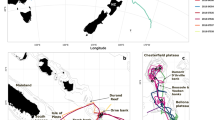Abstract
This paper offers the first study of diurnal variations in the use of an estuarine habitat by Indo-Pacific humpback dolphins. Passive acoustic data loggers were deployed in the Xin Huwei River Estuary, Western Taiwan, from July 2009 to December 2010, to collect biosonar clicks. Acoustic encounter rates of humpback dolphins on the riverside of the estuary changed significantly over the four tidal phases, instead of the two diurnal phases based on the recordings from 268 days. Among the tidal phases, the encounter rates were lowest during ebb tides. Additionally, circling movements associated with the hunt for epipelagic fish significantly changed in temporal and spatial presence over the four tidal phases, matching the overall pattern of encounter rate changes in the focal estuary. Our findings suggest that the occurrence pattern and habitat utilization of humpback dolphins are likely to be influenced by the tidal-driven activity of their epipelagic prey.








Similar content being viewed by others
References
Akamatsu T, Matsuda A, Suzuki S, Wang D, Wang K, Suzuki M, Muramoto H, Sugiyama N, Oota K (2005a) New stereo acoustic data logger for free-ranging dolphins and porpoises. Mar Technol Soc J 39:3–9
Akamatsu T, Wang D, Wang K, Naito Y (2005b) Biosonar behaviour of free-ranging porpoises. Proc R Soc Lond B 272:797–801
Akamatsu T, Wang D, Wang K, Li S, Dong S, Zhao X, Barlow J, Stewart BS, Richlen M (2008) Estimation of the detection probability for Yangtze finless porpoises (Neophocaena phocaenoides asiaeorientalis) with a passive acoustic method. J Acoust Soc Am 123:4403–4411
Akamatsu T, Nakamura K, Kawabe R, Furukawa S, Murata H, Kawakubo A, Komaba M (2010) Seasonal and diurnal presence of finless porpoises at a corridor to the ocean from their habitat. Mar Biol 157:1879–1887
Au WWL (1980) Echolocation signals of the Atlantic bottlenose dolphin (Tursiops truncatus) in open waters. In: Busnel RG, Fish JF (eds) Animal sonar systems. Plenum Press, New York, pp 251–282
Au WWL (1993) The sonar of dolphins. Springer, New York
Au WWL, Penner RH, Turl CW (1987) Propagation of beluga echolocation signals. The J Acoust Soc Am 83:807–813
Barros NB, Jefferson TA, Parsons ECM (2004) Feeding habits of Indo-Pacific humpback dolphins (Sousa chinensis) stranded in Hong Kong. Aquat Mamm 30:179–188
Bel’kovich VM, Ivanova EE, Yefremenkova OV, Kozarovitsky LR, Kharitonov SP (1991) Searching and hunting behavior in the bottlenose dolphin (Tursiops truncatus) in the Black Sea. In: Pryor K, Norris KS (eds) Dolphin societies: discoveries and puzzles. University of California Press, Berkeley and Los Angeles, pp 38–67
Benoit-Bird KJ, Au WWL (2009) Cooperative prey herding by the pelagic dolphin, Stenella longirostris. J Acoust Soc Am 125:125–137
Carlström J (2005) Diel variation in echolocation behavior of wild harbor porpoises. Mar Mamm Sci 21:1–12
Chou LS, Lee JD, Lee PF, Kao CC, Shao KT, Chuang CT, Chen MH, Chen CF, Wei RC, Yang WC, Tsai HC (2011) Population ecology, critical habitat and master planning for marine mammal protected area of Indo-Pacific humpback dolphins, Sousa chinensis. Final Report to Forest Bureau, Council of Agriculture, Republic of China. No. 99-FD-08.1-C-32. http://ethics.forest.gov.tw/public/Attachment/181616351971.pdf (in Chinese)
Franks PJS (1992) Sink or swim: accumulation of biomass at fronts. Mar Ecol Prog Ser 82:1–12
Fury CA, Harrison PL (2011) Seasonal variation and tidal influences on estuarine use by bottlenose dolphins (Tursiops aduncus). Estuar Coast Shelf Sci 93:389–395
Gibson RN (2003) Go with the flow: tidal migration in marine animals. Hydrobiologia 503:153–161
Goold JC, Jefferson TA (2004) A note on clicks recorded from free-ranging Indo-Pacific humpback dolphins, Sousa chinensis. Aquat Mamm 30:175–178
Hanson MT, Defran RH (1993) The behavior and feeding ecology of the Pacific coast bottlenose dolphin, Tursiops truncatus. Aquat Mamm 19:127–142
Hastie GD, Wilson B, Wilson LJ, Parsons KM, Thompson PM (2004) Functional mechanisms underlying cetacean distribution patterns: hotspots for bottlenose dolphins are linked to foraging. Mar Biol 144:397–403
Hung SK (2008) Habitat use of Indo-Pacific humpback dolphins (Sousa chinensis) in Hong Kong. Dissertation. The University of Hong Kong, Hong Kong
Jefferson TA (2000) Population biology of the Indo-Pacific hump-backed dolphin in Hong Kong waters. Wildl Monogr 144:1–65
Jefferson TA, Karczmarski L (2001) Sousa chinensis. Mamm Species 655:1–9
Karczmarski L, Thornton M, Cockcroft VG (1997) Description of selected behaviours of humpback dolphins, Sousa chinensis. Aquat Mamm 23:127–133
Karczmarski L, Cockcroft VG, McLachlan A (2000) Habitat use and preferences of Indo-Pacific humpback dolphins Sousa chinensis in Algoa Bay, South Africa. Mar Mamm Sci 16:65–79
Kimura S, Akamatsu T, Wang K, Wang D, Li S, Dong S, Arai N (2009) Comparison of stationary acoustic monitoring and visual observation of finless porpoises. J Acoust Soc Am 125:547–553
Kimura S, Akamatsu T, Li S, Dong S, Dong L, Wang K, Wang D, Arai N (2010) Density estimation of Yangtze finless porpoises using passive acoustic sensors and automated click train detector. J Acoust Soc Am 128:1435–1445
Krumme U (2004) Patterns in tidal migration of fish in a Brazilian mangrove channel as revealed by a split-beam echosounder. Fish Res 70:1–15
Krumme U (2009) Diel and tidal movements by fish and decapods linking tropical coastal ecosystems. In: Nagelkerken I (ed) Ecological connectivity among tropical coastal ecosystems. Springer Netherlands, Dordrecht, pp 271–324
Largier JL (1993) Estuarine fronts: how important are they? Estuaries 16:1–11
Madsen PT, Johnson M, de Soto NA, Zimmer WMX, Tyack P (2005) Biosonar performance of foraging beaked whales (Mesoplodon densirostris). J Exp Biol 208:181–194
McLusky DS, Elliott M (2004) The estuarine ecosystem: ecology, threats, and management. Oxford University Press, New York
Mellinger DK, Stafford KM, Moore SE, Dziak RP, Matsumoto H (2007) An overview of fixed passive acoustic observation methods for cetaceans. Oceanography 20:36–45
Mendes S, Turrell W, Lütkebohle T, Thompson P (2002) Influence of the tidal cycle and a tidal intrusion front on the spatio-temporal distribution of coastal bottlenose dolphins. Mar Ecol Prog Ser 239:221–229
Moore SE, Stafford KM, Mellinger DK, Hildebrand JA (2006) Listening for large whales in the offshore waters of Alaska. Bioscience 56:49–55
Parra GJ (2006) Resource partitioning in sympatric delphinids: space use and habitat preferences of Australian snubfin and Indo-Pacific humpback dolphins. J Anim Ecol 75:862–874
Parra GJ, Jedensjö M (2009) Feeding habits of Australian snubfin (Orcaella heinsohni) and Indo-Pacific humpback dolphins (Sousa chinensis). Project Report to the Great Barrier Reef Marine Park Authority, Townsville and Reef & Rainforest Research Centre Limitred, Cairns, Australia. http://www.rrrc.org.au/publications/downloads/141e-UQ-Parra-G-etal-2009-Feeding-Habits-of-Snubfin-and-Pacific-Humpback-Dolpins.pdf
Parsons ECM (1998) The behaviour of Hong Kong’s resident cetaceans: the Indo-Pacific hump-backed dolphin and the finless porpoise. Aquat Mamm 24:91–110
Reeves RR, Dalebout ML, Jefferson TA, Karczmarski L, Laidre K, O’Corry-Crowe G, Rojas-Bracho L, Secchi ER, Slooten E, Smith BD, Wang JY, Zhou K (2008) Sousa chinensis (eastern Taiwan Strait subpopulation). In: IUCN 2011. IUCN Red List of Threatened Species. Version 2011.1
Ross PS, Dungan SZ, Hung SK, Jefferson TA, Macfarquhar C, Perrin WF, Riehl KN, Slooten E, Tsai J, Wang JY, White BN, Würsig B, Yang SC, Reeves RR (2010) Averting the Baiji syndrome: conserving habitat for critically endangered dolphins in Eastern Taiwan Strait. Aquat Conserv 20:685–694
Saayman GS, Tayler CK (1979) The socioecology of humpback dolphins (Sousa sp.). In: Winn HE, Olla BL (eds) The behavior of marine animals, vol 3: Cetaceans. Plenum Press, New York, pp 165–226
Scott MD, Wells RS, Irvine AB (1990) A long-term study of bottlenose dolphins on the west coast of Florida. In: Leatherwood S, Reeves RR (eds) The bottlenose dolphin. Academic Press, San Diego, pp 235–244
Soldevilla MS, Wiggins SM, Hildebrand JA (2010) Spatial and temporal patterns of Risso’s dolphin echolocation in the Southern California Bight. J Acoust Soc Am 127:124–132
Soldevilla MS, Wiggins SM, Hildebrand JA, Oleson EM, Ferguson MC (2011) Risso’s and Pacific white-sided dolphin habitat modeling from passive acoustic monitoring. Mar Ecol Prog Ser 423:247–260
Tankersley RA, Forward RB (2001) Selective tidal-stream transport of marine animals. Oceanogr Mar Biol Annu Rev 39:305–353
Thomas JA, Turl CW (1990) Echolocation characteristics and range detection threshold of a false killer whale (Pseudorca crassidens). In: Thomas JA, Kastelein RA (eds) Sensory abilities of cetaceans: laboratory and field evidence. Plenum Press, New York, pp 321–334
Todd VLG, Pearse WD, Tregenza NC, Lepper PA, Todd IB (2009) Diel echolocation activity of harbour porpoises (Phocoena phocoena) around North Sea offshore gas installations. ICES J Mar Sci 66:734–745
Wang JY, Yang SC, Hung SK, Jefferson TA (2007) Distribution, abundance and conservation status of the eastern Taiwan Strait population of Indo-Pacific humpback dolphins, Sousa chinensis. Mammalia 71:157–165
Wang JY, Hung SK, Yang SC, Jefferson TA, Secchi ER (2008) Population differences in the pigmentation of Indo-Pacific humpback dolphins, Sousa chinensis, in Chinese waters. Mammalia 72:302–308
Acknowledgments
This study was supported by the Formosa Plastics Group and Research and Development Program for New Bio-industry Initiatives of Japan. We thank the Tainan Hydraulics Laboratory, National Cheng Kung University, and Industrial Development Bureau, Ministry of Economic Affairs, Taiwan, for allowing us access the fixed pile in the Xin Huwei River Estuary. We appreciate Li-Cing Mei, Long-Jhen Lin, Siou-Syong Wu, and the members of the Cetacean Laboratory, National Taiwan University for their dedicated support to the field surveys on the Indo-Pacific humpback dolphins of the west coast of Taiwan. We thank Wu-Jung Lee, Shiang-Lin Huang, Shane Guan, and Florence Evacitas for reviewing the manuscript.
Author information
Authors and Affiliations
Corresponding author
Additional information
Communicated by U. Siebert.
Rights and permissions
About this article
Cite this article
Lin, TH., Akamatsu, T. & Chou, LS. Tidal influences on the habitat use of Indo-Pacific humpback dolphins in an estuary. Mar Biol 160, 1353–1363 (2013). https://doi.org/10.1007/s00227-013-2187-7
Received:
Accepted:
Published:
Issue Date:
DOI: https://doi.org/10.1007/s00227-013-2187-7




